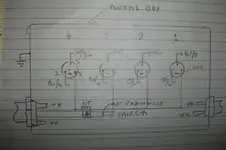aidanknight
Don't Overwrite The Bagel
Good Morning Everyone,
First post ? I apologize if this has been covered in other threads, I tried searching for this exact subject but didn't find an answer.
I am working on a new studio build where I live in Western Canada. 650-750 sq ft, 2 iso rooms (100-ish sq feet each). ISO1 is a drum room with 12 channels of audio + 1-2 HP boxes (probably the Behringer P16 system), ISO2 is a piano and vocals room with 8 channels of audio + 1 HP boxes. 24 channels of audio in the MAINROOM (synths, CP70, misc mic lines, etc). Another 4 channels of audio in the tiled bathroom bc why not! Reverb! So, 48 Channels of audio total coming back to the desk/patchbay.
I would like to run the wiring over CAT5/6 cables (4 analog channels per Cat5), which I understand from many festival FOH folks are great for long cable runs. Plus the Behringer system uses RJ45 connections. Plus I can send video (maybe to a monitor with lyrics/arrangements for performers) and digital signals in general, from what I understand.
I have a few questions:
1. I want to run cabling through the floor, which allows me to avoid punching holes in my walls. What is considered best practice? PVC conduit? Or something shielded?
2. Can I run digital signals alongside analog? I will also be running power through the floor as well, so I have two places/conduits I can put cables. Power in Conduit 1, Cat5's in Conduit 2?
3. Should I install XLR boxes (like the Sound Tools WallCAT) or leave them as RJ45/Ethercon connectors and use breakout boxes (like the Sound Tools CAT Tails)?
4. My interface (Apollo 16 + 8) is only 24 channels, not 48 - Could I use a RJ45 patchbay to patch groups of 4 to my patchbay (DB25)?. For example, ISO1 XLR 1-4 + ISO1 XLR 5-8 + ISO2 XLR 1-4 > PATCHBAY 1-12.
5. What are my options to convert the RJ45/Ethercon to DB25? I've found a few computer networking parts that fit the description but I have no idea if they will work for DB25 audio wiring (probably Tascam)
Really appreciate any insights from anyone who's installed analog audio over CAT5 in their studio. Thanks for reading!
First post ? I apologize if this has been covered in other threads, I tried searching for this exact subject but didn't find an answer.
I am working on a new studio build where I live in Western Canada. 650-750 sq ft, 2 iso rooms (100-ish sq feet each). ISO1 is a drum room with 12 channels of audio + 1-2 HP boxes (probably the Behringer P16 system), ISO2 is a piano and vocals room with 8 channels of audio + 1 HP boxes. 24 channels of audio in the MAINROOM (synths, CP70, misc mic lines, etc). Another 4 channels of audio in the tiled bathroom bc why not! Reverb! So, 48 Channels of audio total coming back to the desk/patchbay.
I would like to run the wiring over CAT5/6 cables (4 analog channels per Cat5), which I understand from many festival FOH folks are great for long cable runs. Plus the Behringer system uses RJ45 connections. Plus I can send video (maybe to a monitor with lyrics/arrangements for performers) and digital signals in general, from what I understand.
I have a few questions:
1. I want to run cabling through the floor, which allows me to avoid punching holes in my walls. What is considered best practice? PVC conduit? Or something shielded?
2. Can I run digital signals alongside analog? I will also be running power through the floor as well, so I have two places/conduits I can put cables. Power in Conduit 1, Cat5's in Conduit 2?
3. Should I install XLR boxes (like the Sound Tools WallCAT) or leave them as RJ45/Ethercon connectors and use breakout boxes (like the Sound Tools CAT Tails)?
4. My interface (Apollo 16 + 8) is only 24 channels, not 48 - Could I use a RJ45 patchbay to patch groups of 4 to my patchbay (DB25)?. For example, ISO1 XLR 1-4 + ISO1 XLR 5-8 + ISO2 XLR 1-4 > PATCHBAY 1-12.
5. What are my options to convert the RJ45/Ethercon to DB25? I've found a few computer networking parts that fit the description but I have no idea if they will work for DB25 audio wiring (probably Tascam)
Really appreciate any insights from anyone who's installed analog audio over CAT5 in their studio. Thanks for reading!


